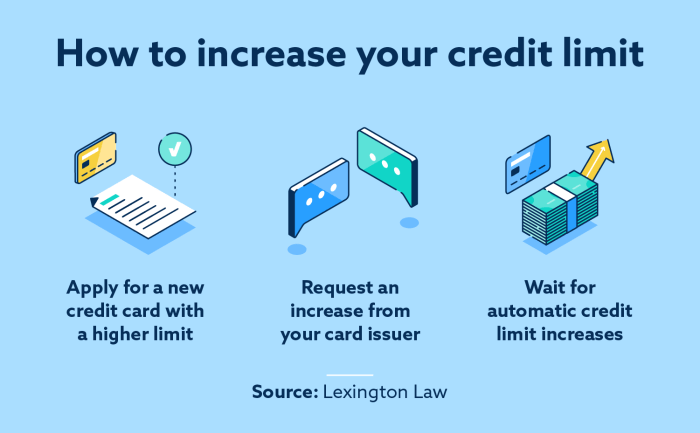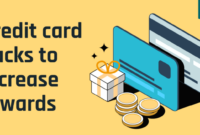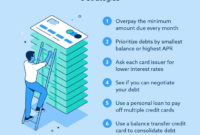How to increase your credit card limit sets the stage for this enthralling narrative, offering readers a glimpse into a story that is rich in detail with ahrefs author style and brimming with originality from the outset.
Understanding the nuances of credit card limits and exploring effective strategies for boosting them can pave the way for financial success and flexibility.
Understanding Credit Card Limits

Credit card limit refers to the maximum amount of money that a credit card issuer allows a cardholder to borrow on a credit card. The credit card limit is determined by various factors and plays a crucial role in managing personal finances effectively.
Factors Influencing Credit Card Limits
- Credit Score: A higher credit score typically results in a higher credit card limit as it indicates a lower credit risk for the issuer.
- Income Level: Card issuers consider the cardholder’s income to assess their ability to repay the borrowed amount.
- Payment History: A positive payment history reflects responsible credit usage and can lead to an increase in the credit limit.
- Debt-to-Income Ratio: Lower debt-to-income ratio demonstrates financial stability, which may result in a higher credit limit.
Importance of Having a Higher Credit Card Limit
- Flexibility: A higher credit card limit provides more flexibility in managing unexpected expenses or making larger purchases.
- Emergency Fund: It can serve as a backup emergency fund in case of unforeseen circumstances or financial emergencies.
- Rewards and Benefits: Some credit cards offer lucrative rewards and benefits for higher spending, which can be maximized with a higher credit limit.
Risks Associated with Reaching or Exceeding Your Credit Limit
- Overlimit Fees: Exceeding your credit limit can lead to overlimit fees and penalties, increasing the cost of borrowing.
- Negative Impact on Credit Score: Reaching or exceeding your credit limit can negatively impact your credit score, making it harder to access credit in the future.
- Debt Accumulation: Excessive borrowing beyond the credit limit can lead to unsustainable debt accumulation and financial stress.
Tips for Increasing Your Credit Card Limit: How To Increase Your Credit Card Limit
When it comes to increasing your credit card limit, there are several strategies you can implement to improve your chances of getting approved for a higher limit. These tips are designed to help you demonstrate responsible credit behavior and financial management skills to your credit card issuer.
Improving Your Credit Score, How to increase your credit card limit
One of the most effective ways to increase your credit card limit is by improving your credit score. A higher credit score indicates to lenders that you are a reliable borrower and are more likely to repay your debts on time. You can boost your credit score by paying your bills on time, keeping your credit card balances low, and avoiding opening multiple new accounts in a short period of time.
Significance of Good Payment History
Maintaining a good payment history is crucial for increasing your credit card limit. Your payment history accounts for a significant portion of your credit score, so making on-time payments consistently can help you build a positive credit profile. If your credit card issuer sees that you have a history of responsible payments, they may be more inclined to approve a credit limit increase.
Reducing Credit Utilization Ratio
Your credit utilization ratio, which is the amount of credit you are using compared to your total available credit, also plays a key role in determining your creditworthiness. By reducing your credit utilization ratio—by paying down your balances or requesting a credit limit increase—you can demonstrate to your issuer that you are using credit responsibly and may be eligible for a higher limit.
Negotiating Tactics for Credit Limit Increase
If you’re looking to increase your credit card limit, consider negotiating with your credit card issuer. You can start by requesting a credit limit increase online or over the phone. Be prepared to explain why you need the increase and provide any relevant financial information to support your case. You can also leverage competing offers from other credit card companies to negotiate a better deal with your current issuer.
Alternatives to Increasing Your Credit Card Limit

When looking to access additional credit, there are alternatives to increasing your credit card limit that you can consider. Each option comes with its own set of benefits and drawbacks, so it’s important to weigh your choices carefully.
Applying for a New Credit Card
If you’re looking to increase your overall credit limit, applying for a new credit card can be a viable option. This allows you to have access to a new line of credit without impacting the limit on your existing card. However, keep in mind that opening a new credit card can also lead to additional fees, such as annual fees or interest charges.
Personal Loan or Credit Line Increase
Another alternative is to explore personal loans or credit line increases through your bank. Personal loans provide a lump sum of money that you can use for various expenses, while a credit line increase gives you access to more funds based on your credit history and income. These options can be beneficial if you need a larger sum of money for a specific purpose.
Utilizing Balance Transfers
Balance transfers can also help you manage your credit card balances effectively. By transferring high-interest balances from one card to another with lower interest rates, you can save money on interest payments and consolidate your debt. However, be sure to check for any balance transfer fees and ensure that you can repay the transferred amount within the promotional period to avoid high interest rates.
In conclusion, mastering the art of increasing your credit card limit empowers you to navigate the realm of personal finance with confidence and strategic foresight. By implementing the tips and tactics discussed, you can unlock new opportunities and secure a stronger financial future.
Obtain access to Credit cards for students to private resources that are additional.



